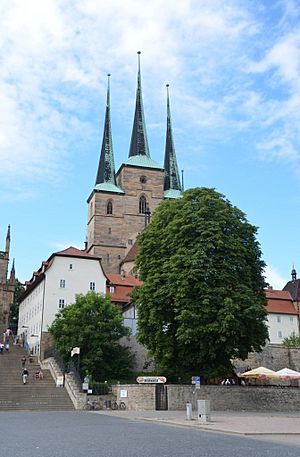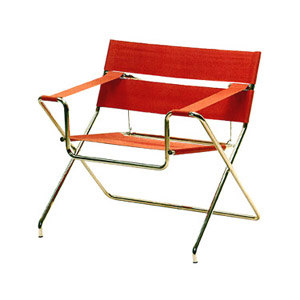Margaretha Reichardt facts for kids
Quick facts for kids
Margaretha Reichardt
|
|
|---|---|
| Born | 6 March 1907 Erfurt, German Empire
|
| Died | 25 May 1984 (aged 77) Erfurt, East Germany
|
| Monuments | Margaretha Reichardt Haus Museum |
| Other names |
|
| Education |
|
| Occupation | Weaver, Textile artist |
| Years active | 1926-1984 |
|
Notable work
|
|
| Spouse(s) | Hans Wagner (m.1936 - div.1952) |
| Awards |
|
Margaretha Reichardt (born March 6, 1907 – died May 25, 1984) was a talented textile artist and weaver from Erfurt, Germany. She was also known as Grete Reichardt. She became one of the most important designers from the famous Bauhaus design school in Germany.
Margaretha spent most of her life running her own weaving workshop in Erfurt. This was a challenging time, as Germany was first under the Nazi government and later became part of communist East Germany.
Contents
Early Life and School
Margaretha Reichardt was born in Erfurt, Germany, on March 6, 1907. Her father was a master tailor and also the sexton (a church official) for the Catholic Severikirche (St Severus' Church).
Her family lived in apartments in Severihof, a large building connected to the church. It overlooked Erfurt's main cathedral square. Margaretha was an only child.
From 1913 to 1921, she went to a Catholic school and then a girls' school run by nuns in Erfurt.
In 1921, when she was only 14, Margaretha got special permission to start training at the Erfurt Kunstgewerbeschule. This was a school for applied arts, where students learned practical design skills. She finished her training in 1925 as a qualified craftswoman.
While at the Kunstgewerbeschule in 1923, she visited the very first Bauhaus exhibition in nearby Weimar. She was very excited by what she saw. This visit later inspired her to apply to the Bauhaus school in 1925. She became student number 83 there.
Studying at the Bauhaus
From 1926 to 1931, Margaretha was a student at the famous Bauhaus design school in Dessau, Germany. She started with a basic course taught by Josef Albers and László Moholy-Nagy. After that, she studied in the Bauhaus weaving workshop. She also took classes from famous artists like Paul Klee, Joost Schmidt, and Wassily Kandinsky.
She passed her Bauhaus journeyman's exam in 1929. A journeyman is someone who has completed an apprenticeship and is skilled in their craft. In 1931, she received her Bauhaus Diploma, becoming the 54th person to earn one.
Between 1929 and 1930, she worked as a traveling teacher in Königsberg. From 1930 to 1931, Margaretha was a freelance workshop master in the Bauhaus weaving workshop.
In 1932, she spent a year in the Netherlands. There, she studied typography (the art of arranging type) and became the director of a weaving workshop in The Hague.
Fun Wooden Toys
In her first year at the Bauhaus in 1926, Margaretha designed two wooden toys that became quite famous. These toys were later made and sold by the Naef toy company in Switzerland.
One toy was called Steckpuppen, or "Peg dolls." It was a set of three brightly painted wooden figures on metal pins. You could move these figures around on their wooden base.
The other toy was a Hampelmann, or "Jumping Jack." This was a painted wooden figure of a man in a wooden frame. His arms and legs would move when you pulled a string.
Amazing Eisengarn Fabric
Margaretha learned from and worked with many well-known Bauhaus artists, including Gunta Stölzl. She created special fabrics for the tubular steel chairs designed by Marcel Breuer.
One of her most important developments was improving a material called Eisengarn. This name means "iron yarn" in English, but it doesn't actually contain any iron. It's a very strong, durable, and waxed cotton material. Fabric made from eisengarn is shiny and very hard to tear.
This material was first developed in Germany in the mid-1800s. Margaretha Reichardt made it even better while she was at the Bauhaus. Her improved eisengarn was used on Marcel Breuer's famous tubular steel chairs. It was also used for airplane seats in the 1930s because it was so strong. She also helped create fabrics that could block sound or reflect light.
Life in Erfurt After Bauhaus
In 1933, Margaretha returned to Erfurt. She was able to get many looms and other equipment from the Bauhaus weaving workshop, which had recently closed. She set up her own workshop in Severihof, the building where her family lived.
In 1936, she married Hans Wagner. For a while, she sometimes used the name Wagner-Reichardt. Hans ran a photography studio with his brother. Margaretha taught Hans how to weave, and they worked together in the workshop. Hans joined the military in 1939, and they divorced in 1952. They did not have any children. After their divorce, Hans started his own weaving workshop.
In 1939, Margaretha and Hans built a house and workshop in Bischleben, a suburb of Erfurt. Margaretha lived and worked there for the rest of her life. She made beautiful wall hangings, carpets, and fabrics for clothes, curtains, and furniture.
She became a Master Weaver in 1942. This meant she was qualified to teach apprentices (students learning a trade).
During the time of the Nazi government, Margaretha Reichardt had to be a member of the Reichskulturkammer. This was a government organization that all German artists had to join to work professionally.
In 1946, she taught for a year in the textile department of a school in Erfurt. This school was in the same building as the Kunstgewerbeschule she had attended as a young woman.
In 1952, Reichardt joined the artists' association of East Germany.
In communist East Germany, small independent businesses like Margaretha Reichardt's workshop were allowed. However, it was hard to get raw materials because the government controlled everything. Margaretha had to be very good at negotiating with officials. She also got materials from contacts in other countries, especially in Scandinavia.
In 1953, there was political unrest in East Germany. Margaretha was offered teaching jobs in West Germany, but she chose to stay in Erfurt.
On December 2, 1976, Margaretha was one of 18 former Bauhaus students and teachers who attended the official reopening of the Bauhaus building in Dessau. The East German government had restored it.
Her Weaving Business
Margaretha Reichardt's weaving business was called Handweberei Grete Reichardt. When she worked with her husband, Hans Wagner, it was called Handweberei Wagner-Reichardt. Her workshop trained over 50 apprentices during her lifetime, with up to five at a time.
They made carpets, wall hangings, furniture covers, clothing fabrics, and other decorative items. They also created textiles for museums, theaters, and public buildings. Even though the cloth was handwoven, clothes made from it were sold in regular shops and were affordable for many people.
In 1963, Margaretha hand-wove one of three tapestries for the restored St. Hedwig's Cathedral in Berlin. It showed a city with the names of the apostles, a Tree of Life representing God, and a lamb as a symbol of Christ.
Death and Legacy
Margaretha Reichardt passed away suddenly at her home in Erfurt-Bischleben on May 25, 1984, at the age of 77. She was still managing her workshop right up until her death.
A street in Erfurt, Grete Reichardt Straße, is named after her. There are other streets in the area named after famous Bauhaus figures because Erfurt is close to Weimar, where the Bauhaus school began.
Margaretha Reichardt Museum
After Margaretha Reichardt died, people wanted to preserve her home and workshop as a museum. In 1987, her home, workshop, and all its contents (including her looms and garden) became a protected monument. In 1989, it officially became a museum for the city of Erfurt, called the Margaretha Reichardt Haus.
The house was built in 1939. The plans were drawn by Konrad Püschel, who was also a Bauhaus student with Reichardt. It looks like a traditional house of its time, not a typical flat-roofed Bauhaus building.
At the museum, you can see her workshop on the lower ground floor. It has six original wooden hand looms, two of which came from the Bauhaus weaving workshop in Dessau. You can also visit parts of her living area, which look just as they did when she was alive. These rooms display her carpets and wall hangings, and some original Bauhaus furniture. This includes a Marcel Breuer tubular steel chair covered with Reichardt's eisengarn fabric. You can also see a "Peg doll" toy model. The museum also has a collection of textiles and clothing made in her workshop.
Since 1992, the Margaretha Reichardt Haus has been managed by the Angermuseum Erfurt, the city's main art gallery. You can visit by appointment and take tours that include a demonstration of how the looms work.
Exhibitions and Collections
Margaretha Reichardt's work was shown in over 20 solo exhibitions during her lifetime. Many exhibitions have also been held since her death. Her work was also displayed at handcrafts exhibitions at the Grassi Museum in Leipzig for many years. The Leipzig Museum of Applied Arts has her work in its permanent collection.
The Angermuseum Erfurt also has her work. In 2019, it held an exhibition called Vier "Bauhausmädels" (Four Bauhaus Girls), featuring Margaretha Reichardt and three other female Bauhaus artists.
The archive of the Bauhaus-Universität Weimar holds 31 drawings and 11 textile items she made at the Bauhaus in Dessau.
She received an honorary diploma at the International Exposition of Art and Technology in Modern Life in Paris in 1937. In 1951, she won an honorary golden diploma at the Milan Triennial IX for a handwoven tapestry.
Examples of Reichardt's Bauhaus work are held by the New York Museum of Modern Art (MoMA). They were part of a major exhibition called Bauhaus 1919–1933: Workshops for Modernity in 2009-2010.
Clothing made from her textiles and a carpet design were shown in the Bauhaus: Art as Life exhibition in London in 2012.
The Cooper Hewitt, Smithsonian Design Museum in New York has a B5 chair covered with her Eisengarn fabric. Her work is also in other private and public collections, including the Bauhaus Dessau Foundation.
Examples of Work
- Formost.de. Margaretha Reichardt. (Wooden toys)
- Bauhaus 2019. Fischweib. A tapestry called "Mermaid," made between 1926 and 1931.
- Bauhaus 2019. Teppich. A design for a carpet, drawn between 1926 and 1930.
- Bauhaus 2019. Gartenstadt (1961). A wall hanging called "Garden City" from 1961.
- Bauhaus 2019. Der Schreiber (1968). A tapestry called "The Scribe" from 1968.
- Bauhaus 2019. Bauhaus-Teppich (1978). A wall hanging called "Bauhaus Carpet" from 1978.
- Bauhaus 2019. Quadrat schwarz-weiss I (1978). A tapestry called "Square black-white I" from 1978.
- Bauhaus 2019. Quadrat schwarz-weiss II (1978). A tapestry called "Square black-white II" from 1978.
See also
- Anni Albers
- Gunta Stölzl
- Otti Berger



